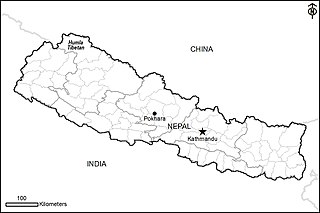Related Research Articles

The Tibetic languages form a well-defined group of languages descended from Old Tibetan. According to Tournadre (2014), there are 50 languages, which split into over 200 dialects or could be grouped into 8 dialect continua. These languages are spoken in the Tibetan Plateau and in the Himalayas in Gilgit-Baltistan, Aksai Chin, Ladakh, Nepal, Himachal Pradesh, Uttarakhand, Bhutan, and the Kachin State of Myanmar. Classical Tibetan is the major literary language, particularly for its use in Buddhist literature.
Khams Tibetan is the Tibetic language used by the majority of the people in Kham. Khams is one of the three branches of the traditional classification of Tibetic languages. In terms of mutual intelligibility, Khams could communicate at a basic level with the Ü-Tsang branch.

Gurung, also known as Tamu Kyi or Tamu Bhāṣā, is a Sino-Tibetan language spoken by the Gurung people of Nepal. The total number of all Gurung speakers in Nepal was 227,918 in 1991 and 325,622 in 2011.
Magar Dhut is a Sino-Tibetan language spoken mainly in Nepal, southern Bhutan, and in Darjeeling and Sikkim, India, by the Magar people. It is divided into two groups and further dialect divisions give distinct tribal identity. In Nepal 810,000 people speak the language.
The Bantawa Language, is a Kiranti language spoken in the eastern Himalayan hills of eastern Nepal by Kirati Bantawa ethnic groups. They use a syllabic alphabet system known as Kirat Rai. Among the Khambu or Rai people of Eastern Nepal, Sikkim, Darjeeling and Kalimpong in India, Bantawa is the largest language spoken. According to the 2001 National Census, at least 1.63% of the Nepal's total population speaks Bantawa. About 370,000 speak Bantawa Language mostly in eastern hilly regions of Nepal (2001). Although Bantawa is among the more widely used variety of the Bantawa language, it falls in the below-100,000 category of endangered languages. It is experiencing language shift to Nepali, especially in the northern region.
Mugom language, also known as Mugom-ket, is the Sino-Tibetan language of the Mugali people of Mugu district in Nepal.

South Asia is home to several hundred languages, spanning the countries of Afghanistan, Bangladesh, Bhutan, India, Maldives, Nepal, Pakistan, and Sri Lanka. It is home to the third most spoken language in the world, Hindi–Urdu; and the sixth most spoken language, Bengali. The languages in the region mostly comprise Indo-Iranic and Dravidian languages, and further members of other language families like Austroasiatic, and Tibeto-Burman languages.

The Tharu or Tharuhat languages are any of the Indo-Aryan languages spoken by the Tharu people of the Terai region in Nepal, and neighboring regions of Uttarakhand, Uttar Pradesh and Bihar in India.

The Tamangic languages, TGTM languages, or West Bodish languages or Kaike-Ghale-Tamangic languages (Glottolog), are a family of Sino-Tibetan languages spoken in the Himalayas of Nepal. They are called "West Bodish" by Bradley (1997), from Bod, the native term for Tibet. TGTM stands for Tamang-Gurung-Thakali-Manang.
Central Tibetan, also known as Dbus, Ü or Ü-Tsang, is the most widely spoken Tibetic language and the basis of Standard Tibetan.

The Walung people are the indigenous inhabitants of the region around Olangchung Gola. They are descended from Tibetan settlers from the 7th century. The primary occupation of the Walung people is trade and herding yaks and dzos. The Walung have resided in Nepal for a long time, but exactly how long is unknown. Estimates range from 1,300 years to just a few centuries. In the oldest recorded study conducted in the area in 1855, Joseph Hooker reported that the Walung had been there for centuries or longer.
Sak is a Sino-Tibetan language of the Sal branch spoken in Bangladesh and Myanmar by the Chak people.
Rawat (Raute), or "Jangali" (Jungle), is a small Sino-Tibetan language of India. It is spoken in 9 villages north of Askot in Pithoragarh district, Uttarakhand, India (Ethnologue) as well as in several villages in Dadeldhura District, Nepal and Darchula District, Nepal.
Magar Kaike is a Sino-Tibetan language of Nepal. Ethnologue classifies it as a West Bodish language.
Thakali is a Sino-Tibetan language of Nepal spoken by the Thakali people, mainly in the Myagdi and Mustang Districts. Its dialects have limited mutual intelligibility.
Ghale is a Sino-Tibetan dialect cluster of Nepal that may be part of the Tamangic family. The people who speak them are ethnically Tamang, but their languages are too poorly known to be sure. The two languages, Kutang and Ghale, might each be considered more than one language.

Kyirong–Kagate is a subgroup of Tibetic languages spoken primarily in Nepal, with a hundred or so speakers across the border in Tibet.
Rana may refer to the following varieties:

Nubri is a Tibeto-Burman language spoken by about 2000 ethnically Tibetan people living in Nubri Valley in northern Central Nepal, upper Gorkhā District of Gandaki Province. Nubri has at least three dialects as typified by the Prok, Lho and Sama village varieties. Nubri is largely undocumented and undescribed, with the exception of a lexicon. Nubri is perhaps most closely related to neighbouring Tsum language and the Kyirong variety of Tibetan spoken just across the border in Tibet. It has also been claimed to be closely related to Gyalsumdo. Like these languages it is tonal and shares many Tibetic grammatical features, but is uniquely different in many ways.

Humla Tibetan, also known as Humla Bhotiya, and Humli Tamang, is the Sino-Tibetan language of the Tibetan people of Humla district in Nepal.
References
- ↑ Kutang at Ethnologue (18th ed., 2015) (subscription required)
- ↑ Childs, Geoff (2004). Tibetan Diary. University of California Press. p. 22.
